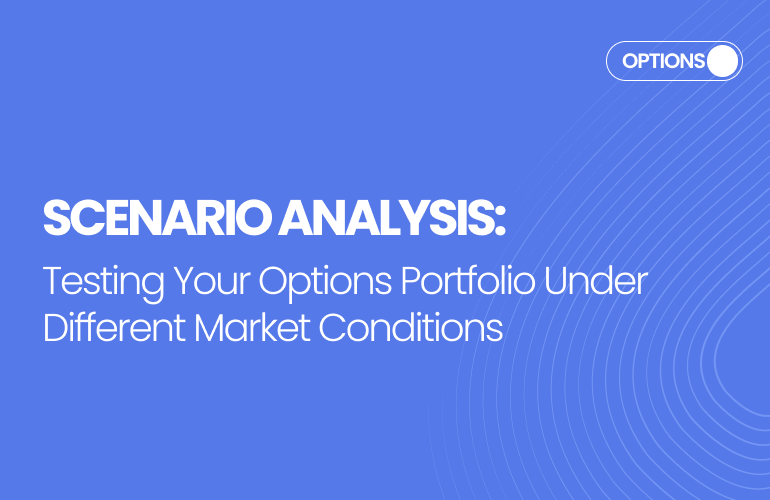When trading crypto options, understanding your potential P&L in best-case and worst-case outcomes is crucial. Given crypto’s extreme volatility, portfolio scenario analysis lets you model your options portfolio under different market conditions—bullish, bearish, sideways, or high volatility, and respond with confidence.
Option scenario analysis isn’t just for institutions. It’s a must-have edge for individual traders aiming for consistent profitability.
What Is Scenario Analysis in Options Trading?
Scenario analysis simulates how your current or planned options positions will perform under hypothetical market conditions.
It helps answer questions like:
- What happens if BTC dumps 10% overnight?
- How will my theta-decay behave in a sideways market?
- Will my vega exposure hurt me during a volatility crash?
Why It’s Critical for Crypto
Crypto trades 24/7: You must anticipate overnight gaps and weekend swings.
Volatility spikes are frequent: Event-driven moves can destroy untested strategies.
Market cycles are brutal: Bull-to-bear reversals happen fast.
This makes scenario analysis for crypto traders an essential tool for survival.
Setting Up Scenarios for Crypto Portfolios
Market Movement Scenarios
Simulate how your options react to price changes in the underlying crypto:
- Mild move (±2%)
- Moderate move (±5%)
- Black swan (±10–15%)
For each scenario:
- Check profit/loss per leg and net position
- Monitor changes in delta and gamma
Volatility Shocks
Since implied volatility (IV) is a major component in options pricing, simulate:
- IV drop of 20% (post-announcement calm)
- IV spike of 30% (pre-event uncertainty)
This is where crypto options portfolio analysis becomes critical in testing vega-heavy positions.
Time Decay Progression
Advance time by 3, 7, or 14 days and analyze:
- Theta decay on short vs. long options
- Impact on credit spreads and calendar spreads
Multi-Variable Stress Tests
Try combinations like:
- BTC down 5% + IV up 25% + 7 days passed
- ETH up 3% + IV drops + near expiry
Such scenario analysis examples reveal how complex portfolios behave in reality.
Tools and Methods for Scenario Analysis
Manual Method
Use spreadsheets to input:
- Strike, premium, IV, delta, theta, vega
- Assumed future spot price and IV
Then:
- Use Black-Scholes calculator to simulate outcomes
- Recalculate P&L and Greeks
Platform-Based Tools
Platforms like Deribit, TradingView (with options overlay), and Pi42 (coming soon) offer:
- Real-time options payoff charts
- Custom option scenario analysis
- Integrated Greeks visualization
Python-Based Simulations (Advanced)
If you code:
- Use QuantLib or py_vollib to model Greeks and simulate under N-day scenarios
- Run Monte Carlo simulations for probabilistic outcomes
Practical Use Cases for Options Traders
Hedging a Spot Position
Scenario: You hold 1 BTC and buy a protective put.
- What if BTC falls 10%? → How much loss is offset?
- What if IV rises? → Will put value increase beyond intrinsic?
Selling Options in High-IV Markets
Scenario: Shorting straddles before a known event.
- What if IV collapses post-event?
- What if price breaks through your breakeven range?
Building Delta-Neutral Portfolios
Use scenario analysis in risk management to test whether your delta-neutral position:
- Remains hedged during moderate moves
- Needs adjustment when gamma kicks in
Actionable Risk Management from Scenario Analysis
Red Flags to Watch For
- Extreme negative gamma: Means loss accelerates on sharp moves
- Negative theta with long time to expiry: Bleeds capital over time
- High negative vega in low-IV environment: Volatility risk is underestimated
Position Adjustments Based on Outcomes
- Roll strikes or expiries to adjust exposure
- Add hedging legs (e.g., buying further OTM puts)
- Exit positions where skew or IV has already played out
Rebalancing Frequency
- Weekly during quiet markets
- Daily during volatile periods or event weeks
Effective risk management with scenario analysis helps traders stay profitable even in chaotic markets.
Conclusion
Trading without options portfolio risk analysis is like driving with your eyes closed. In crypto, where price swings are routine, portfolio scenario analysis transforms you from reactive to prepared.
When you simulate your options portfolio across price moves, volatility shocks, and time decay, you gain true risk control and a clear edge.
Want to start trading smarter? Use Pi42 to test, adjust, and execute crypto options trades with built-in analytics and risk insights.
Keep Learning:
Volatility Trading: Trading With Implied Volatility Options in Crypto
Option Greeks Explained: Delta, Gamma, Theta, Vega, Rho
Options Market-Making in Crypto: Risk Management and Edge Explained

